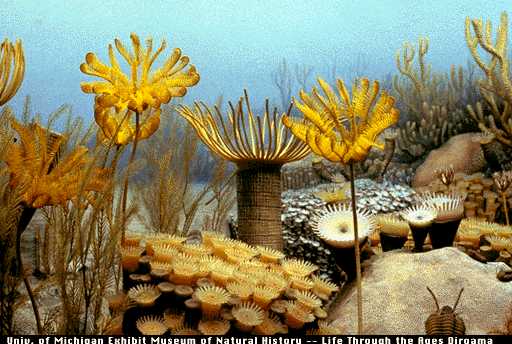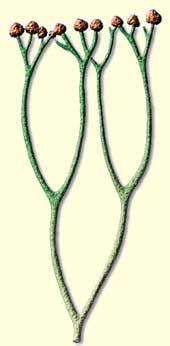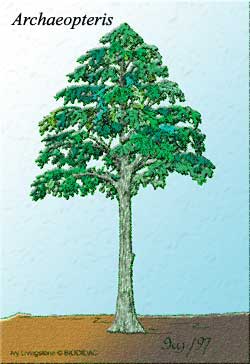
| Palaeos: Paleozoic |  |
Devonian Period |
| Devonian Period | Devonian - 2 |
| Page Back | Back: Silurian | Back: Neoproterozoic | Up: Paleozoic | Unit Home |
| Page Next | Next: Carboniferous | Next: Mesozoic | Down: Early Devonian | Timescale |

 Types of marine life: In Devonian seas, sponges were represented by newly evolved siliceous forms, many of which were similar to the modern Venus flower basket. The association between algae, sponges, and corals that began in the Ordovician
continued, with flourishing reefs, such as the one illustrated in the above diorama, thriving in the warm shallow seas. During this time not only the hylaesponges,
rugose and
tabulate corals (shown above) but
also the brachiopods reached their zenith in number and diversity. The spiriferid brachiopods (left) were particularly abundant. Among molluscs, while gastropods, bivalves, and nautiloids continue with little change from the Silurian, the first
ammonoids mark the beginning of an important new phase of molluscan evolution. Trilobites were generally on the decline, but a few groups remained abundant, and some giant forms evolved, such as the huge spiny Terataspis grandis (30 to 60 cm). The increase in swimming predators (such as new forms of fish and cephalopods) may have contributed to the trilobite decline.
Types of marine life: In Devonian seas, sponges were represented by newly evolved siliceous forms, many of which were similar to the modern Venus flower basket. The association between algae, sponges, and corals that began in the Ordovician
continued, with flourishing reefs, such as the one illustrated in the above diorama, thriving in the warm shallow seas. During this time not only the hylaesponges,
rugose and
tabulate corals (shown above) but
also the brachiopods reached their zenith in number and diversity. The spiriferid brachiopods (left) were particularly abundant. Among molluscs, while gastropods, bivalves, and nautiloids continue with little change from the Silurian, the first
ammonoids mark the beginning of an important new phase of molluscan evolution. Trilobites were generally on the decline, but a few groups remained abundant, and some giant forms evolved, such as the huge spiny Terataspis grandis (30 to 60 cm). The increase in swimming predators (such as new forms of fish and cephalopods) may have contributed to the trilobite decline.
 The Devonian saw the rapid evolution diversification of fish, especially the Placodermi,
primitive sharks, Sarcopterygii
(lobe-finned fish and lungfish) and Actinopterygii (conventional bony fish or ray-finned fish). So pronounced is this evolutionary radiation that the Devonian has been called "the age of Fish".
The Devonian saw the rapid evolution diversification of fish, especially the Placodermi,
primitive sharks, Sarcopterygii
(lobe-finned fish and lungfish) and Actinopterygii (conventional bony fish or ray-finned fish). So pronounced is this evolutionary radiation that the Devonian has been called "the age of Fish".
Terrestrial life: Many arthropods, including eurypterids, arachnids (spiders and their kin) and primitive wingless insects invaded the land. Towards the end of the period the first fish-like tetrapods move ashore. Seed-bearing plants (Gymnosperms) also appeared during the latest Devonian. Seeds mean a freedom from dependence on moist habitats for reproduction, and allowed plants to expand into drier areas.
There is a major mass extinction during the Late Devonian (the so-called Frasnian-Famennian event). The tabulate-stromatoporoid reefs disappear completely, with corals so seriously decimated that extensive reef building did not happen until the Triassic with the evolution of a new group of reef-building corals, the scleractinians. Brachiopods, trilobites and primitive fish groups either were either diminished or completely killed off, as were many planktonic and nektonic (floating and swimming) animals. The planktonic graptolites and enigmatic tentaculites die out and trilobites are much reduced. Tropical taxa were the most severely affected. The effect on terrestrial ecosystems was not as marked.
Various causes have been suggested. Global cooling tied to Gondwanan glaciation has been proposed as the cause of the Devonian extinction, as it was also suspected of in the case of the terminal Ordovician extinction. Support for this hypothesis comes from the fact that the forms of marine life most affected by the extinction were the warm water to tropical ones. Another hypothesis is that environmental sea-level and climatic change in conjunction with an extraterrestrial impact (comet/asteroid) caused a global cooling. There are several impact sites known to be of the right potential age to have been involved in this extinction. But neither the glaciation or the impact hypothesis is unequivocally supported by the available data.
Cross-reference:
 Coccosteus site.
Coccosteus site.
 The
subject of Devonian plants is one that has occupied numerous scholars for their
entire professional lives. Obviously, we are not going to be able to do it
justice here. We have discussed various aspects of the matter in
connection with the Rhynie Chert. At Paleozoic
Plants, we include a few paragraphs specifically on Devonian plants, with
links to more extensive treatment of individual taxa.. Finally, we include
links to several of the many good web sites on this topic below.
Consequently, there is no obvious need for yet another summary of this topic
here -- assuming we cared whether or not there was a need. As the
astute reader will already have perceived, that sort of utilitarian calculus is
rarely involved in decision-making at Palaeos -- assuming an astute
reader would be reading Palaeos at all, instead of some more authoritative
source. But enough of this dizzying ontological circuity. Let us
attend to the subject at hand.
The
subject of Devonian plants is one that has occupied numerous scholars for their
entire professional lives. Obviously, we are not going to be able to do it
justice here. We have discussed various aspects of the matter in
connection with the Rhynie Chert. At Paleozoic
Plants, we include a few paragraphs specifically on Devonian plants, with
links to more extensive treatment of individual taxa.. Finally, we include
links to several of the many good web sites on this topic below.
Consequently, there is no obvious need for yet another summary of this topic
here -- assuming we cared whether or not there was a need. As the
astute reader will already have perceived, that sort of utilitarian calculus is
rarely involved in decision-making at Palaeos -- assuming an astute
reader would be reading Palaeos at all, instead of some more authoritative
source. But enough of this dizzying ontological circuity. Let us
attend to the subject at hand.
The Devonian Period was, for plants, a sort of Cambrian explosion. Plants began the Devonian, just as animals began the Cambrian, with a small amount of important, but largely cryptic diversity. That is, some of the important groups had already diverged, but we have not yet found much of that divergence in the fossil record. Just as almost all kinds of animals looked more or less like flatworms in the earliest Cambrian, almost all land plants looked more or less like Cooksonia at the end of the Silurian. Important specializations had already occurred, but they are hidden by a poor fossil record of small plants which all look more or less the same. However, by the end of the Devonian, plants had adapted to land in many different forms. They had evolved structures capable of raising dense forests up to 30 meters against the force of gravity (e.g., Archaeopteris); and were making far more effective use of the resources available to them. However, the "explosion" of forms consisted largely in developing and refining the key evolutionary innovations already present at the beginning of the Period.
 The
structure of this revolution is revealed by comparing Cooksonia with Late
Devonian plants. Cooksonia
itself was already a vascular plant with the key features of the true vascular
land plants [1]. That is, it
had a specialized vascular system (tracheids) composed of the cell walls
of dead cells (xylem) to
transport water and nutrients upward. The walls of the tracheids were somewhat thickened to
support the stem against gravity. However, the amount of reinforcing
material was small and it may not have been the lignin (woody tissue) of
later tracheophytes. Cooksonia also had tiny, adjustable vents (stoma)
for gas exchange, and well-developed sporangia (spore-bearing
reproductive structures). Although it lacked a massively reticulated root
system, it did have a sort of taproot and ground-level side branches (rhizomes),
both bearing root hairs. What it lacked were leaves, the
massive lignin supports of more derived plants, and seeds. These were
acquired in approximately that phylogenetic order.
The
structure of this revolution is revealed by comparing Cooksonia with Late
Devonian plants. Cooksonia
itself was already a vascular plant with the key features of the true vascular
land plants [1]. That is, it
had a specialized vascular system (tracheids) composed of the cell walls
of dead cells (xylem) to
transport water and nutrients upward. The walls of the tracheids were somewhat thickened to
support the stem against gravity. However, the amount of reinforcing
material was small and it may not have been the lignin (woody tissue) of
later tracheophytes. Cooksonia also had tiny, adjustable vents (stoma)
for gas exchange, and well-developed sporangia (spore-bearing
reproductive structures). Although it lacked a massively reticulated root
system, it did have a sort of taproot and ground-level side branches (rhizomes),
both bearing root hairs. What it lacked were leaves, the
massive lignin supports of more derived plants, and seeds. These were
acquired in approximately that phylogenetic order.
Cooksonia itself is a member of the rhyniophytes, the basal radiation of vascular plants (Tracheophyta). In broad outline, the Devonian progress of the group looks like this:
TRACHEOPHYTA |--rhyniophytes = "Rhyniopsida": paraphyletic, includes Cooksonia
`--+--Lycophyta: lycopods (club moss) and zosterophylls `--+--Monilophyta: horsetails & ferns `--+--Trimerophytopsida: Trimerophyton, Psilophyton & Pertica `--Progymnospermopsida: seed plants and a few others
Some of the rhyniophytes had already developed "spikes" and various other excuses for increasing surface area to catch more sunlight. The problem is that more surface area also means faster water loss by evaporation. It took a bit longer to evolve the waxy covering that allows plants to form broad leaves. Leaves are present in all of the more derived groups, and seem to have developed at first by growing "webbing" of photosynthetic tissues between small twigs.
Wood is also a Devonian innovation. Wood means axial strength, which means the ability to grow taller to reach open sunlight and to carry a greater weight of branches and leafy, photosynthetic surface per meter of height. Thus it is no surprise that we go from the rather flaccid stems of Cooksonia to the true wood of progymnosperms by the Middle Devonian. As soon as the environment of land plants came to be dominated by other land plants, the race would be on to join one of the four great plant guilds: (a) trees (tall-growing plants that shade out the competition), (b) shrubs (low, shade tolerant, densely growing plants that crowd out competition), (c) weeds (fast-growing, opportunistic, adventitious plants that outrun competition by spreading quickly through temporarily open spaces) and (d) survivalists (hardy plants that colonize marginal environments where no competitors can live). Wood is plainly an essential for members of the tree guild.
monilophytes and trimerophytes developed refinements of the vascular system, particularly secondary xylem and, in progymnosperms, phloem, the specialized vascular tissue that moves the products of photosynthesis down from the leaves to other regions of the plant. This suggests that these plants first developed as shrubs, selected for dense, efficient growth.
It was left to the Carboniferous to develop the seed, a device which, like the amniotic egg of vertebrates, allowed plants to spread far from open water. However, by the end of Devonian, both plants and vertebrates were solidly established on the terrestrial margins and poised to colonize the interior highlands.
Links: The Earliest Land Plants; Devonian Times; Introduction to the Progymnosperms; Lab VII - The Origin of Seed Plants (2).
Image: the image of Archaeopteris was adapted from the incomparable materials at Biodidac. ATW040711.
![]() The Devonian - the best over-all introduction.
The Devonian - the best over-all introduction.
![]() The Devonian Page - nice basic intro - easy to understand - actually a class project
The Devonian Page - nice basic intro - easy to understand - actually a class project
![]()
![]()
![]() Devonian Times - all about the first tetrapods (four-legged animals). Gives an excellent coverage of the new paradigm that the first tetrapods amphibians were not so much crossopterygian fish crawling on land to a new pond to escape drought (and only evolving
legs afterwards), but rather fish
with legs (i.e. legs evolved before moving on land).
Devonian Times - all about the first tetrapods (four-legged animals). Gives an excellent coverage of the new paradigm that the first tetrapods amphibians were not so much crossopterygian fish crawling on land to a new pond to escape drought (and only evolving
legs afterwards), but rather fish
with legs (i.e. legs evolved before moving on land).
![]()
![]() The
Devonian 'Great Barrier Reef' in what is now West Australia
The
Devonian 'Great Barrier Reef' in what is now West Australia
![]()
![]() Browse
the Fossil Gallery - Devonian Period - a small selection of Devonian fossils from Nova Scotia
Browse
the Fossil Gallery - Devonian Period - a small selection of Devonian fossils from Nova Scotia
![]()
![]() Devonian Age of Kentucky - the fossils of this time and two illustrations
Devonian Age of Kentucky - the fossils of this time and two illustrations
![]()
![]() The Devonian Period in Victoria - some photos of fossils from
Victoria (South-East Gondwana)
The Devonian Period in Victoria - some photos of fossils from
Victoria (South-East Gondwana)
![]() The Great Devonian Controversy : The Shaping of Scientific Knowledge Among Gentlemanly Specialists by Martin J. S. Rudwick - the history of science, relating to the 19th century discovery of Devonian-age rocks
The Great Devonian Controversy : The Shaping of Scientific Knowledge Among Gentlemanly Specialists by Martin J. S. Rudwick - the history of science, relating to the 19th century discovery of Devonian-age rocks
[1] Phylogenetic taxonomy has not caught on completely among paleobotanists, with the result that there is still a certain amount of pointless debate about exactly what characters should be used to define the Tracheophyta. We respectfully submit that characters should never be used to define taxa at all. Tracheophyta ought to be defined as all organisms more closely related to mangroves than to moss (or some equivalent). Then we could move on to the real job of figuring out what they have in common and who belongs to the group. See discussion at Cladograms.
| Page Back | Unit Home | Page Up | Page Top | Page Next |